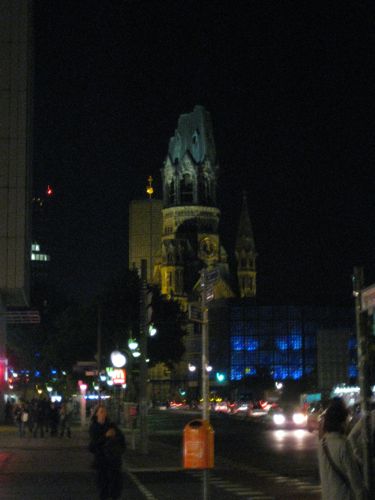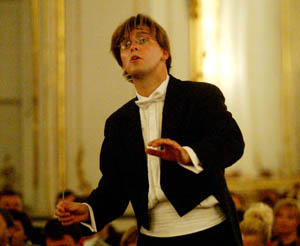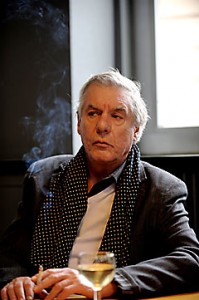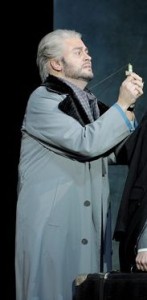
I’ve just returned from a 9 day stint sampling the artistic delights of the city of Berlin. My visit was a work/play combo, and I spent a good amount of time cooking up project ideas with my dear friend, the brilliant playwright Branden Jacobs-Jenkins, while also packing my schedule full of symphonic/operatic shows. [Speaking of Brandon, anyone in L.A. (as I will be next week) should totally go see his play this month (just click upon his linkèd name).]
I went to Berlin hoping to be disabused of all the usual rumors surrounding German classical music-making, but I’ve ended up finding them all to be true. In no particular order:
1) German orchestras play with less technical precision but more gusto/musicality than their American counterparts. True. Although it’s not like they’re particularly lacking in the technical department either. My first night in Berlin, I heard the Deutsches Symphonie, probably the second or third orchestra of the city of Berlin, but they played with a passion, beauty and energy that would outmatch many if not most of America’s top orchestras. The piece was Verdi’s Requiem, the conductor James Conlon. Hearing the orchestra of the Komische Oper play the score of Die Meistersinger a few days later was a similarly revelatory experience – the orchestra played with real command and gorgeous color under the direction of their new, young Chefdirigent, Patrick Lange.
2) The professional radio choirs of Northern Europe/Scandinavia* are the best around.
I had this choir director in college who was basically abhorrent in every way, and she would often ramble incessantly about the quality of the radio choirs in Berlin and Stockholm. Well, the Rundfunkchor-Berlin was the resident choir for the Verdi Requiem that I heard, and they really were all that. About half the size of a typical US Symphonic choir, they packed twice the punch, and you could really get a sense of each singer’s individual artistic contribution to the whole, but not in a distracting, sticking-out sort of way.
However, I do think that the Bach choir of Tokyo is maybe second best. And I would never want to discount the recent achievements of Chicago’s own Grant Park Symphony Chorus. But from my brief experience with the RFC-Berlin, I’d say this group combines the best of a large symphonic choir and a small chamber choir.
[*I’m just kind of assuming that the Swedish Radio Choir is really great in person too… their recordings are superb enough.]
3) The Berlin Philharmonic is the best orchestra in the world.
The particular concert that I attended really illustrates what makes this orchestra great. The conductor was this guy,  Tomáš Netopil,
Tomáš Netopil,
a young Czech conductor standing in for the not-so-recently deceased Sir Charles Mackerras. He’s young, very energetic and makes music at a very high level, that’s for certain. What’s not certain, though, is what to make of his interpretations. The concert I heard contained two pieces: excerpts from Martinů’s opera Julliette and Dvořák’s Symphony No. 7. I know very little about the Martinů repertoire in general except that I tend to really like his music and I always wonder why we don’t hear more of it on concert programs (my teacher recorded a bunch of his stuff though, which you should totally buy).
But I sure as hell do know Dvořák’s 7th, at least enough to say that Mr. Netopil’s was a very unusual interpretation. One obvious point is that he used a totally different second movement, recently uncovered and edited by Jonathan Del Mar (who may be the most famous editor of classical music, assuming that such a thing actually exists.) This new second movement was quite lovely, though it’s always jarring to hear a re-composition of something so very familiar. My impression is that this alternate movement offers more in terms of color and fantasy but lacks the formal tidiness of the movement we usually hear.
But I digress. The thing about Mr. Netopil’s rendering of Dvořák’s 7th is that it was constantly on the brink – the tempi were generally quite fast but with lots and lots of modification, and he offered a gamut of surprises in terms of balance and color. But I simply can’t judge it as an interpretation because the musicians of the orchestra made it work perfectly. At times, it seemed as if the entire thing was going to disintegrate into a pile of mush — tempos would be pushed to such extremes that I didn’t know how the strings would possibly be able to play together, or how a particular wind player would conceivably be able to fit his rhythm into what the rest of the orchestra was doing. And yet, they did it with aplomb.
There wasn’t anything the least bit casual about it even though it sounded totally natural; the orchestra played with more concentration and intensity than any other I have ever seen. The furthest back players in all the string sections were as committed as the principals. It was easily best orchestral performance I have ever attended.
[Caveat: the Vienna Philharmonic is a personal favorite, but it’s not exactly a normal orchestra – positions in the orchestra are handed down from father to son, they play these weird, ancient instruments that are not used by any other players in any other orchestra in the world, they supposedly mark their bowings in pen, etc…]
4) Eurotrash. Not so much an axiom as a word, but the opera productions I saw in Berlin (Meistersinger, Traviata, and a trio of abstract chamber operas by Boris Blacher) left much to be desired. Many of you are probably familiar with the typical problems in German opera staging, and I should probably clarify my stance by saying that my argument is not with a particular aesthetic, but with the lazy attitude and sloppy work that accompanies most Eurotrash opera productions (it certainly applied to the ones that I saw.)
I fully understand that there are compelling reasons to update the costumes, sets and “concepts” of a given opera. It makes sense that directors and designers should incorporate contemporary visual and artistic references into the operas they produce. If the references are meaningful to audiences, the characters and dramatic situations in an opera can gain a vividness and relevance that might not be possible when staged traditionally. Or maybe these visual touches bring out some previously undiscovered dimension to the piece. And that’s great. I recently went down to Bloomington to see the opening of IU’s opera season, a magnificent production of Barber of Seville directed by Nicholas Muni. It had a kitschy, dark aesthetic to it and the costumes and set pieces really heightened the story-telling and comedy.
In Berlin, at the Komische Oper, however, all I saw was lazy, incompetent direction and design. Every single cliché of the regietheater was on display: mirrors on the floors, exposed stage apparati, extraneous nudity, food being thrown, changed endings, etc. What I didn’t see was well-rounded characterization, thoughtful relationships, connections between words, music and drama, or anything that elucidated the action of the story with a modicum of interest. Die Meistersinger von Nürnburg is a 5 1/2 hour long opera. In the Komische Oper’s production, first two acts staged with costumes and sets exclusively in gray and brown. That’s a rather monotonous color story for 3 1/2 hours of opera. Then, in the third act, when the holiday festivities commence – what do you know? Colors! And this is supposed to qualify as an interesting artistic decision? All I saw was a sucky collision of Dogville and The Wizard of Oz.
Then there’s the Traviata directed by this guy, Hans Neuenfels:
 and even though I like basically everything about this picture of him, sitting through his production, I felt overwhelmingly that he should be drawn and quartered. Let’s take as an example of his ‘craft’, his rendering of the character of Giorgio Germont. This is really a complex character, a deeply religious man who asks Violetta, a woman he barely knows, to make an enormous personal sacrifice for the sake of his family. What’s more, he feels a strongly paternal affection to Violetta upon meeting her. So, wrapped into this character is a real conflict and a number of dimensions. Here’s what he looked like in Mr. Neuenfels’ production:
and even though I like basically everything about this picture of him, sitting through his production, I felt overwhelmingly that he should be drawn and quartered. Let’s take as an example of his ‘craft’, his rendering of the character of Giorgio Germont. This is really a complex character, a deeply religious man who asks Violetta, a woman he barely knows, to make an enormous personal sacrifice for the sake of his family. What’s more, he feels a strongly paternal affection to Violetta upon meeting her. So, wrapped into this character is a real conflict and a number of dimensions. Here’s what he looked like in Mr. Neuenfels’ production:

See how he’s thrusting his crucifix in other characters faces like a talisman? That’s exactly what he spends about 90% of his stage time doing. What you don’t see is his footwear, and the fact that one of his feet is cloven. Cloven. Like a goat. Because, you see, religious people are really evil and hypocritical. And it’s interesting and edgy to point that out. Except when it’s not, which is like most of the time, but it’s particularly uninteresting in this opera. Presenting this character in this light renders him way less interesting than a seated reading of the libretto would.
This post has sort of derailed, and I should point out that I loved Berlin and my experiences there, and my friend Branden is totally the best, but let me just end with this: Opera Directors, I hereby encourage you on behalf of whomever – let’s say the opera-going public – to work hard to re-invigorate constantly the operatic cannon with every production. Dig deeply into the libretto and the score and try to access and interact with the combined intelligences of the librettist and the composer.  Create a bold interpretation and invite your audiences into a revelatory night of theater. Please!! It’s what we want. But if you dig and dig and can’t find a way to express the piece and to express yourself through the piece, just don’t do it. You know what? YOU COULD EVEN WRITE YOUR OWN OPERA. Go ahead! It’s very hard work, let me assure you. I just hope you aren’t frustrated by the efforts of your interpreters.
Good stuff, Maestro. I’m pretty floored that you dubbed the Berlin concert “easily the best orchestral performance” you’d ever attended. That’s quite a few concerts. What would they be like in the hands of our dear friend Valery?